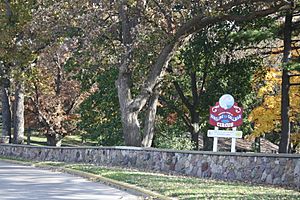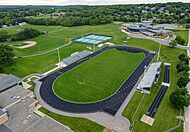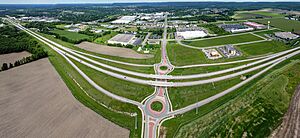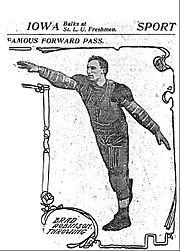Baraboo, Wisconsin facts for kids
Quick facts for kids
Baraboo, Wisconsin
|
|
|---|---|
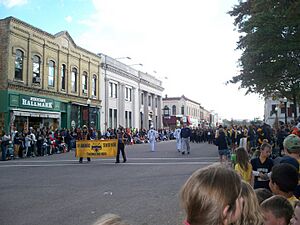
Downtown Baraboo (2010)
|
|
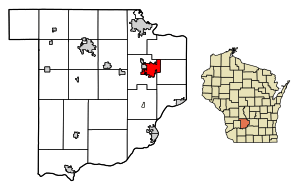
Location of Baraboo in Sauk County, Wisconsin
|
|
| Country | United States |
| State | Wisconsin |
| County | Sauk |
| Incorporated (village) | April 6, 1866 |
| Incorporated (city) | February 25, 1882 |
| Government | |
| • Type | Mayor – Council |
| Area | |
| • City | 7.43 sq mi (19.25 km2) |
| • Land | 7.35 sq mi (19.03 km2) |
| • Water | 0.09 sq mi (0.22 km2) |
| Elevation | 879 ft (268 m) |
| Population
(2020)
|
|
| • City | 12,556 |
| • Density | 1,709.2/sq mi (659.9/km2) |
| • Metro | 55,225 |
| Time zone | UTC−6 (Central) |
| • Summer (DST) | UTC−5 (CDT) |
| ZIP Code |
53913
|
| Area code(s) | 608 |
| GNIS feature ID | 1582749 |
| FIPS code | 55-04625 |
Baraboo (![]() i/ˈbɛərəbuː/ bair-Ə-boo) is the county seat of Sauk County, Wisconsin, United States, located along the Baraboo River. The population was 12,556 as of the 2020 census. The most populous city in the county, Baraboo is the principal city of the Baraboo micropolitan statistical area which comprises a portion of the Madison combined statistical area.
i/ˈbɛərəbuː/ bair-Ə-boo) is the county seat of Sauk County, Wisconsin, United States, located along the Baraboo River. The population was 12,556 as of the 2020 census. The most populous city in the county, Baraboo is the principal city of the Baraboo micropolitan statistical area which comprises a portion of the Madison combined statistical area.
Baraboo is home to the Circus World Museum and the former headquarters and winter home of the Ringling Brothers Circus. The Al. Ringling Theatre is an active landmark in the city. Baraboo is near Devil's Lake State Park and Aldo Leopold's Shack and Farm.
Contents
History
Early settlement
The area around Baraboo was the site of a Kickapoo village as early as 1665. The current community was established by Abe Wood in 1838, and was originally known as the village of Adams. In 1839 several settlers arrived and started building cabins, and a saw mill. In 1846 it became the county seat of Sauk County after a fierce fight with the nearby village of Reedsburg. In 1852, the village was renamed "Baraboo", after the nearby river. It was incorporated as a village in 1866 and as a city in 1882. In the 1860s, the city had surpassed a population of 2,000, and many businesses started to form, including grocery stores, banks, and hotels. In 1872, the Chicago and North Western Railway (C&NW) was built. Baraboo became home to several saw mills during this time, because of its location near the Baraboo and Wisconsin Rivers.
Late 1800s to present
In 1884, the Ringling Brothers Circus was established in Baraboo by circus performers and tourers the Ringling brothers, after they settled in the city in 1875 and performed their first show in Mazomanie, Wisconsin in 1882. Several other circuses then came to the city, which earned Baraboo the nickname "Circus City".
Located south of Baraboo in the Census-designated place of Bluffview, was the Badger Ordnance Works, which was the largest munitions factory in the world during World War II. It was later demolished and now the land is a part of the Sauk Prairie Recreation Area.
Hank Snow's 1959 song "I've Been Everywhere", famously covered by Johnny Cash, mentions visiting Baraboo.
Cirrus, a manufacturer of single-engine aircraft, was founded in a rural Baraboo barn in 1984 by the Klapmeier brothers. After a few years of designing the VK-30, they relocated to the Baraboo–Dells Airport and in 1994 moved the company to its present-day home in Duluth, Minnesota.
Geography
According to the United States Census Bureau, the city has a total area of 7.47 square miles (19.35 km2), of which 7.39 square miles (19.14 km2) is land and 0.08 square miles (0.21 km2) is water.
West Baraboo, a suburb of Baraboo, borders the city on its west side.
Baraboo gives its name to the Baraboo Syncline, a doubly plunging, asymmetric syncline in Proterozoic-aged Baraboo quartzite. Researchers at the University of Wisconsin, particularly Charles R. Van Hise, used the syncline to demonstrate that small-scale deformational structures in isolated outcrops reflect larger regional structures and that sedimentary structures could indicate the original top-facing direction within elaborately deformed strata. These two principles sparked a global revolution in structural geology during the 1920s.
The nearby Baraboo Hills are designated one of the "Last Great Places" by the Nature Conservancy because of its rare rocks, plants and animals. The hills were created by glacial action, and in some points poke up from the flat terrain to form a stark contrast. Some of these features were created when a glacial pocket was formed during the Wisconsin glaciation where the advance of the glacier halted, along the edge of what is known as the Driftless Area. Devil's Lake State Park, Wisconsin's largest state park, contains large areas of the Baraboo Hills. Pewits Nest is located outside Baraboo.
Climate
According to the Köppen Climate Classification system, Baraboo has a warm-summer humid continental climate, abbreviated "Dfb" on climate maps. The hottest temperature recorded in Baraboo was 103 °F (39.4 °C) on July 5–7, 2012, while the coldest temperature recorded was −45 °F (−42.8 °C) on January 30, 1951.
| Climate data for Baraboo, Wisconsin, 1991–2020 normals, extremes 1893–present | |||||||||||||
|---|---|---|---|---|---|---|---|---|---|---|---|---|---|
| Month | Jan | Feb | Mar | Apr | May | Jun | Jul | Aug | Sep | Oct | Nov | Dec | Year |
| Record high °F (°C) | 57 (14) |
69 (21) |
84 (29) |
92 (33) |
96 (36) |
102 (39) |
103 (39) |
102 (39) |
99 (37) |
92 (33) |
76 (24) |
68 (20) |
103 (39) |
| Mean maximum °F (°C) | 46.8 (8.2) |
52.7 (11.5) |
67.3 (19.6) |
78.5 (25.8) |
86.5 (30.3) |
91.4 (33.0) |
92.9 (33.8) |
91.3 (32.9) |
87.8 (31.0) |
80.6 (27.0) |
65.4 (18.6) |
52.1 (11.2) |
94.9 (34.9) |
| Mean daily maximum °F (°C) | 27.5 (−2.5) |
32.2 (0.1) |
44.1 (6.7) |
57.2 (14.0) |
69.6 (20.9) |
79.0 (26.1) |
82.8 (28.2) |
80.9 (27.2) |
73.7 (23.2) |
60.5 (15.8) |
45.5 (7.5) |
33.2 (0.7) |
57.2 (14.0) |
| Daily mean °F (°C) | 18.6 (−7.4) |
22.4 (−5.3) |
33.6 (0.9) |
45.6 (7.6) |
57.9 (14.4) |
67.6 (19.8) |
71.5 (21.9) |
69.3 (20.7) |
61.7 (16.5) |
49.5 (9.7) |
36.6 (2.6) |
24.9 (−3.9) |
46.6 (8.1) |
| Mean daily minimum °F (°C) | 9.6 (−12.4) |
12.5 (−10.8) |
23.1 (−4.9) |
34.1 (1.2) |
46.2 (7.9) |
56.2 (13.4) |
60.1 (15.6) |
57.6 (14.2) |
49.7 (9.8) |
38.4 (3.6) |
27.6 (−2.4) |
16.6 (−8.6) |
36.0 (2.2) |
| Mean minimum °F (°C) | −15.9 (−26.6) |
−11.3 (−24.1) |
−2.3 (−19.1) |
16.9 (−8.4) |
28.8 (−1.8) |
39.4 (4.1) |
46.4 (8.0) |
43.4 (6.3) |
31.7 (−0.2) |
21.3 (−5.9) |
8.1 (−13.3) |
−6.6 (−21.4) |
−19.6 (−28.7) |
| Record low °F (°C) | −45 (−43) |
−41 (−41) |
−34 (−37) |
−2 (−19) |
19 (−7) |
31 (−1) |
38 (3) |
34 (1) |
20 (−7) |
10 (−12) |
−17 (−27) |
−35 (−37) |
−45 (−43) |
| Average precipitation inches (mm) | 1.35 (34) |
1.36 (35) |
2.21 (56) |
4.16 (106) |
4.28 (109) |
5.58 (142) |
4.79 (122) |
4.53 (115) |
3.85 (98) |
2.91 (74) |
2.20 (56) |
1.68 (43) |
38.90 (988) |
| Average snowfall inches (cm) | 11.3 (29) |
10.1 (26) |
5.9 (15) |
2.6 (6.6) |
0.0 (0.0) |
0.0 (0.0) |
0.0 (0.0) |
0.0 (0.0) |
0.0 (0.0) |
0.4 (1.0) |
2.1 (5.3) |
10.3 (26) |
42.7 (108.9) |
| Average precipitation days (≥ 0.01 in) | 8.3 | 7.3 | 9.1 | 11.2 | 13.1 | 11.8 | 10.2 | 10.1 | 10.4 | 10.4 | 8.1 | 8.9 | 118.9 |
| Average snowy days (≥ 0.1 in) | 6.7 | 5.8 | 3.1 | 1.0 | 0.0 | 0.0 | 0.0 | 0.0 | 0.0 | 0.2 | 1.5 | 5.5 | 23.8 |
| Source 1: NOAA | |||||||||||||
| Source 2: National Weather Service | |||||||||||||
Demographics
| Historical population | |||
|---|---|---|---|
| Census | Pop. | %± | |
| 1850 | 255 | — | |
| 1860 | 1,360 | 433.3% | |
| 1870 | 1,528 | 12.4% | |
| 1880 | 3,266 | 113.7% | |
| 1890 | 4,605 | 41.0% | |
| 1900 | 5,751 | 24.9% | |
| 1910 | 6,324 | 10.0% | |
| 1920 | 5,538 | −12.4% | |
| 1930 | 5,545 | 0.1% | |
| 1940 | 6,415 | 15.7% | |
| 1950 | 7,264 | 13.2% | |
| 1960 | 7,660 | 5.5% | |
| 1970 | 7,931 | 3.5% | |
| 1980 | 8,081 | 1.9% | |
| 1990 | 9,203 | 13.9% | |
| 2000 | 10,711 | 16.4% | |
| 2010 | 12,048 | 12.5% | |
| 2020 | 12,556 | 4.2% | |
| U.S. Decennial Census | |||
Baraboo forms the core of the United States Census Bureau's Baraboo Micropolitan Statistical Area, which includes all of Sauk County (2000 population: 55,225). The Baraboo μSA is just northwest of the Madison metropolitan area, with which it forms the Census Bureau's Baraboo-Madison Consolidated Metropolitan Statistical Area.
2020 census
As of the census of 2020, the population was 12,556. The population density was 1,709.2 inhabitants per square mile (659.9/km2). There were 5,776 housing units at an average density of 786.3 per square mile (303.6/km2). The racial makeup of the city was 88.0% White, 1.4% Native American, 1.3% Black or African American, 1.0% Asian, 2.7% from other races, and 5.6% from two or more races. Ethnically, the population was 5.9% Hispanic or Latino of any race.
2010 census
As of the census of 2010, there were 12,048 people, 5,161 households, and 3,016 families residing in the city. The population density was 1,630.3 inhabitants per square mile (629.5/km2). There were 5,619 housing units at an average density of 760.4 per square mile (293.6/km2). The racial makeup of the city was 94.0% White, 1.3% African American, 1.0% Native American, 0.5% Asian, 0.1% Pacific Islander, 1.5% from other races, and 1.6% from two or more races. Hispanic or Latino people of any race were 3.7% of the population.
There were 5,161 households, of which 30.2% had children under the age of 18 living with them, 41.1% were married couples living together, 11.8% had a female householder with no husband present, 5.5% had a male householder with no wife present, and 41.6% were non-families. 34.4% of all households were made up of individuals, and 14.7% had someone living alone who was 65 years of age or older. The average household size was 2.26 and the average family size was 2.89.
The median age in the city was 38 years. 23.8% of residents were under the age of 18; 8% were between the ages of 18 and 24; 27.5% were from 25 to 44; 25.1% were from 45 to 64; and 15.6% were 65 years of age or older. The gender makeup of the city was 49.1% male and 50.9% female.
Education
A campus of the University of Wisconsin–Platteville Baraboo Sauk County is located in Baraboo.
The School District of Baraboo has four elementary schools serving students in grades 1 through 5, one kindergarten center, one middle school and one high school (Baraboo High School).
The middle school has a swimming pool that can be accessed by the public with a seasonal membership option. There are also three parochial schools: St. Joseph's Catholic School, which serves Pre-K through sixth grade; St. John's Lutheran School of the WELS, serving Pre-K through eighth grade; and Community Christian School, serving 4K through high school.
St. Joseph's Catholic, under the Roman Catholic Diocese of Madison, is a parochial school. The current school building, designed by the Wisconsin Rapids company Billmeyer and Sons and with a cost of over $500,000, has 11 classrooms. The basement has a cafeteria and a combination auditorium/gymnasium. The second building for the school opened on a filled-in ravine in 1912, northeast of its associated church. The building had three floors and a basement. The first and second floors each had three classrooms, and the second floor also housed the chapel and the library. The third floor had a 600-seat auditorium while the basement had a large banquet hall/gymnasium. The second building became overcrowded due to the post-World War II baby boom, so the third school building, north of the second building, opened in 1958.
The Baraboo Public Library serves the community. The former Free Congregational Society church was demolished by 1902 for the library's construction.
Infrastructure
Baraboo includes the Downtown Baraboo Historic District, which consists of 75 commercial and civic buildings built between 1870 and 1938. The Sauk County Courthouse is in the center of the district, and it serves the county.
Transportation
The Baraboo-Wisconsin Dells Airport (KDLL) serves the city and surrounding communities, and is located on Bus. US 12 3 miles north of the city. State Highways 33, 113, 136, and U.S. 12 pass through Baraboo. There is access to Interstate 90/94 nearby. The Wisconsin & Southern Railroad provides freight rail service to Baraboo via the Reedsburg Subdivision, the nearest Amtrak passenger rail station is in neighboring Wisconsin Dells. Dial-a-ride transit service is available in the city through Baraboo Transit.
Historic sites
- The Aldo Leopold Shack and Farm. celebrated in his book A Sand County Almanac (1949), is near Baraboo.
- The Gust Brothers' Store is in Baraboo.
- The Walworth D. Porter Duplex Residence is in Baraboo.
Notable people
- Donald R. Atkinson, educator and writer
- Frank Avery, Wisconsin State Senator
- Stan Barnes, judge, United States Court of Appeals for the Ninth Circuit
- Virgil H. Cady, Wisconsin State Representative
- Tiny Cahoon, NFL player
- Jorge A. Carow, Wisconsin State Representative
- Ella D. Crawford, temperance movement organizer
- John V. Diener, mayor of Green Bay, Wisconsin
- Evan Alfred Evans, judge of the U.S. Court of Appeals
- Evan Glodell, film director, producer, writer, and actor
- Elna Jane Hilliard Grahn, educator
- Henry C. Hansbrough, U.S. Senator from North Dakota
- John R. Hofstatter, Wisconsin State Representative
- Guy E. Holmes, musician and composer
- John J. Jenkins, U.S. Representative
- Robert J. Keller, Wisconsin State Representative
- Alan and Dale Klapmeier, founders of Cirrus Aircraft
- Len Koenecke, MLB player
- Belle Case La Follette, lawyer and activist
- Nancy Lange, First Lady of Peru
- Louise M. Lawson (1855–1951), president, Wisconsin State Woman's Christian Temperance Union
- Aldo Leopold, naturalist
- Daryl Morey, former general manager of the Houston Rockets (2007–2020), currently the president of basketball operations for the Philadelphia 76ers
- Mary Mortimer (1816–1877), British-born American educator
- Beryl Newman, Medal of Honor recipient
- John Ringling North, president and director of Ringling Bros. and Barnum & Bailey Circus
- Stuart Palmer, mystery novelist
- Delando Pratt, Wisconsin State Representative
- Mike Reinfeldt, NFL player and executive
- Cyrus Remington, Wisconsin State Representative and jurist
- Bradbury Robinson, threw the first forward pass in football history, grew up in Baraboo
- Algie Martin Simons, socialist newspaper editor, attended high school in Baraboo
- Terry Stieve, NFL player
- Walter Terry, Wisconsin legislator
- John M. True, Wisconsin legislator
- C. F. Viebahn, Wisconsin State Representative
- David Vittum, Wisconsin State Senator
- Lewis N. Wood, Wisconsin State Representative
- Edwin E. Woodman, Wisconsin State Senator
See also
 In Spanish: Baraboo (Wisconsin) para niños
In Spanish: Baraboo (Wisconsin) para niños


